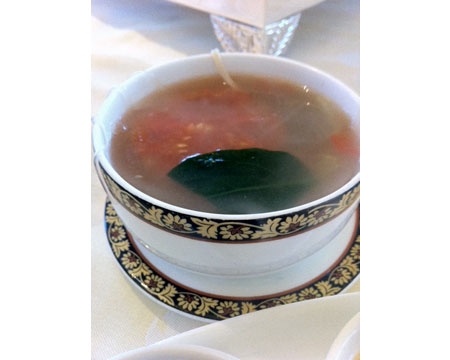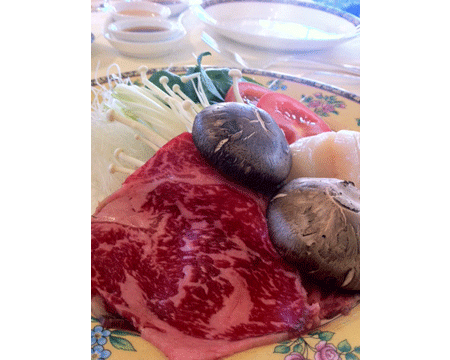Food, History, And Fine Flavors At Jasmine In The Bellagio
Jasmine at the Bellagio Resort has long been a stable amongst locals and tourists alike in Las Vegas. The fifth Vegas Uncork'd featured great events up and down the Las Vegas strip. Perhaps one of the most interesting and educational was a Culinary Revelation event featuring shabu-shabu cooking. Jasmine's Executive Chef Philip Lo and Bellagio Executive Chef Edmond Wong teamed up with Bon Appétit's features editor Hugh Garvey for a tasty educational afternoon.
Chef Lo explained that shabu-shabu dates back to the 13th century in the days of Genghis Khan. As a solution to efficiently feed his soldiers, he developed shabu-shabu (hot pot) form of cooking. The hungry Mongol soldiers would gather around a large pot and cook thinly sliced meat by dipping them in the boiling hot water. Not only did this feed the troops nutritiously and efficiently, but it also helped conserve the army's limited fuel resources. The thinly sliced meat was used primarily because of its short cooking time. This cooking technique supposedly spread to the south during the Tang dynasty then throughout the country, and soon it was all over Asia. As a direct result, many Asian ethnic groups have their own version of shabu-shabu. Shabu-shabu is a Japanese variant.
The dish is related to sukiyaki in style, in that both use thinly sliced meat and vegetables and are usually served with dipping sauces, but it is considered to be more savory and less sweet than sukiyaki. It is considered a winter dish but is eaten year-round.
 Chef Wong added that shabu-shabu was introduced in Japan in the 20th century with the opening of a shabu-shabu restaurant Suehiro in Osaka. Its origins are traced back to the Chinese hot pot known as "shuan yang rou." Shabu-shabu is most similar to the original Chinese version when compared to other Japanese dishes (nabemono) such as sukiyaki. The name of shabu-shabu was named when Suehiro served it. After that, Suehiro registered the name of shabu-shabu as a trademark in 1955. The cuisine rapidly spread through Asia. Together with sukiyaki, shabu-shabu is a common dish in tourist hot-spots, especially in Tokyo, but also in local Japanese neighborhoods in countries such as the United States and Canada.
Chef Wong added that shabu-shabu was introduced in Japan in the 20th century with the opening of a shabu-shabu restaurant Suehiro in Osaka. Its origins are traced back to the Chinese hot pot known as "shuan yang rou." Shabu-shabu is most similar to the original Chinese version when compared to other Japanese dishes (nabemono) such as sukiyaki. The name of shabu-shabu was named when Suehiro served it. After that, Suehiro registered the name of shabu-shabu as a trademark in 1955. The cuisine rapidly spread through Asia. Together with sukiyaki, shabu-shabu is a common dish in tourist hot-spots, especially in Tokyo, but also in local Japanese neighborhoods in countries such as the United States and Canada.
The dish is traditionally made with thinly sliced beef, though modern preparations sometimes use pork, crab, chicken, duck, or lobster. Most often, tender rib eye steak is used, but less tender cuts such as top sirloin are also common. A more expensive meat, such as wagyu, may also be used to enhance flavor and texture.
It is usually served with tofu and vegetables, including Chinese cabbage, chrysanthemum leaves, nori (edible seaweed), onions, carrots, shiitake and enokitake mushrooms. In some places, udon, mochi, or harusame noodles may also be served.
 The dish is prepared by submerging a very thin slice of meat or a piece of vegetable in a pot of boiling water or dashi (broth) made with kombu (kelp) and swishing it back and forth several times. The familiar swishing sound is where the dish gets its name. Shabu-shabu directly translates to "swish-swish." Cooked meat and vegetables are usually dipped in ponzu or "goma" (sesame seed) sauce before eating, and served with a bowl of steamed white rice. Once the meat and vegetables have been eaten, leftover broth from the pot is customarily combined with the remaining rice, and the resulting soup is usually eaten last.
The dish is prepared by submerging a very thin slice of meat or a piece of vegetable in a pot of boiling water or dashi (broth) made with kombu (kelp) and swishing it back and forth several times. The familiar swishing sound is where the dish gets its name. Shabu-shabu directly translates to "swish-swish." Cooked meat and vegetables are usually dipped in ponzu or "goma" (sesame seed) sauce before eating, and served with a bowl of steamed white rice. Once the meat and vegetables have been eaten, leftover broth from the pot is customarily combined with the remaining rice, and the resulting soup is usually eaten last.
The dips were a mouthwatering selection of satay sauce, sesame seed vinegar and fresh chili soy sauce. Of course, a nice Pinot Noir or even a Sauvignon Blanc would have paired nicely, but in our case a Hitachino Nest Commemorative Ale and Asahi Black Kuronama Lager fit the bill just fine. What better way could there be than to spend an afternoon with two renowned chefs while sharing great conversation, learning some ancient food history, and enjoying its tasty rewards!